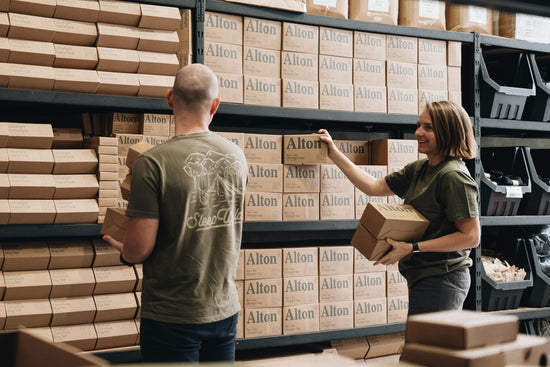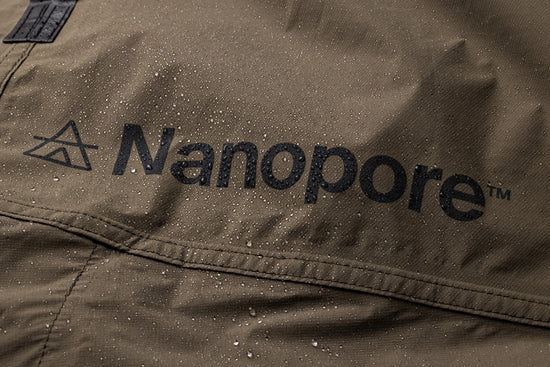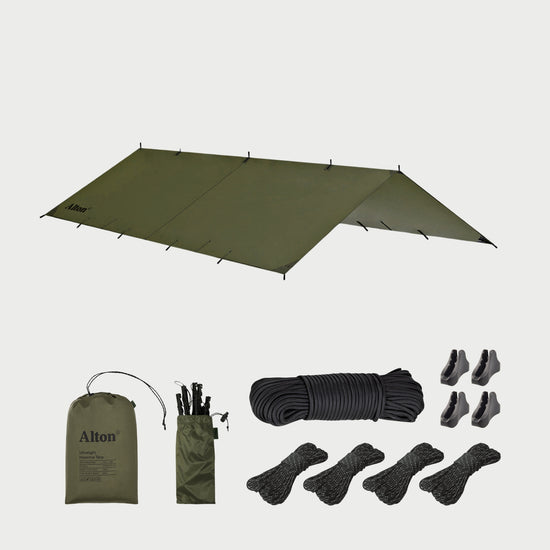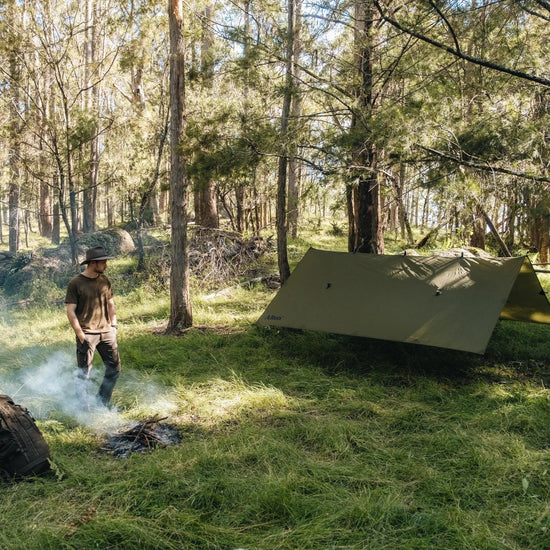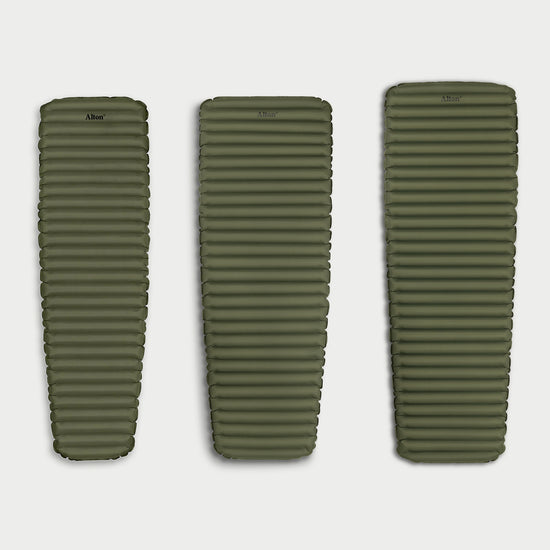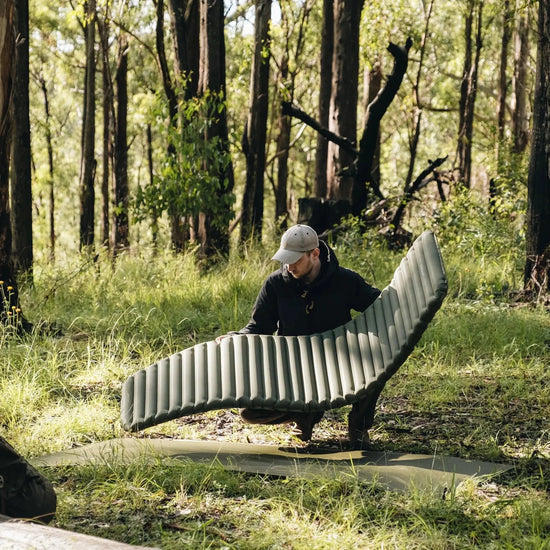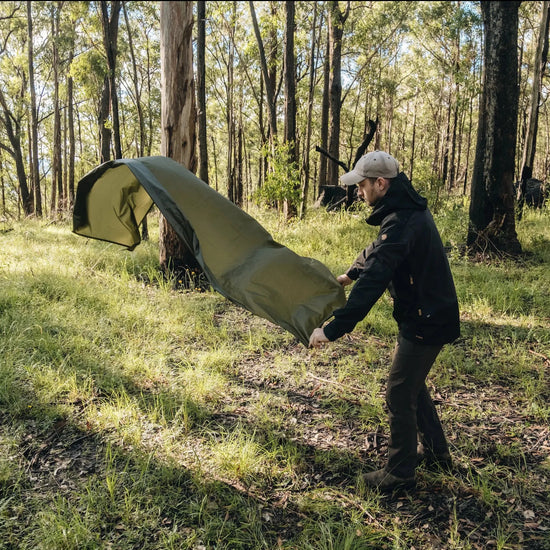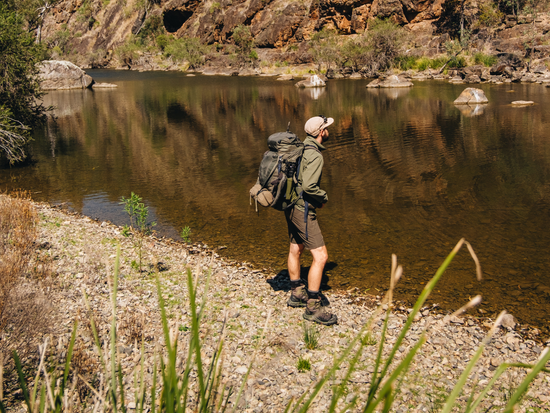At its core, bushcraft teaches us to rely on our knowledge and skills to utilise the resources nature provides.
It is not about having everything. It's about having the right things – and knowing what to do with them.
Today in our Bushcraft Basics blog series, we’re unpacking one of our favourite topics: gear.
In this article, we’ll share our own field-tested bushcraft gear list, as well as general advice on how to choose each item and what they can be used for.
Let’s do it!
What bushcraft activities is this gear list intended for?
Building a shelter. Cooking over a campfire. Foraging for food. Making a fishing net by hand.
All of these fall under the umbrella of bushcraft.
This bushcraft gear list is going to be tailored for activities such as building, crafting and campfire cooking.
Note, it won’t include hunting and fishing supplies – these are highly specialised activities that require a specific set of skills, knowledge, and equipment. We’ll dive into those topics another day soon.
How to use this bushcraft gear guide
There is a saying among bushcrafters to ‘take only what you really need’.
The keyword there is YOU.
This bushcraft gear checklist is a starting point to build your own personalised bushcraft kit that meets YOUR needs.
What you need is going to vary depending on the climate and conditions you’ll be in, the activities you’ll be doing and, of course, your own personal preferences.
So, as you read through this list, remember it is not an exhaustive inventory of everything you need for bushcraft adventures.
You might find you need some of it, all of it – or potentially none of it.

What gear do you need in your bushcraft kit?
Here a quick rundown of our bushcraft gear checklist:
Bushcraft Tools
- Fire Starter
- Bushcraft Knife
- Bushcraft Saw
- Bushcraft Axe or Hatchet
- Multi-Tool
- Shovel or Trowel
Shelter & Sleeping
- Camping Tarp
- Sleeping Bag (or Camping Quilt)
- Sleeping Mat
- Other Options: Bivvy, Tent, Hammock, Bug Net
Camp Kitchen Supplies
- Billy Pot
- Plate, Bowl
- Ultralight Cutlery
- Camping Mug
- Metal Water Bottle
- Water Purification Method
- Cleaning Kit
Outdoor Accessories
- Headtorch
- Work Gloves
- Compass
- Paracord
- Duct Tape
- Notebook & Pencil
Health & Safety Supplies
- First-Aid Kit
- Whistle
- Personal Locator Beacon
It goes without saying, you’ll also need the basics required on any camping trip, such as a backpack, clothing, personal hygiene items, food and water.
Let’s take a closer look at some of the gear we’ve mentioned in the checklist above.

Bushcraft Tools
Fire Starter
There are a few options when it comes to fire starters, including ferrocerium rods, fresnel lenses, waterproof matches and flint strikers. It is worthwhile carrying at least a couple of these options at all times.
IMPORTANT! Always abide by local fire restrictions in place and never leave a campfire unattended.
Bushcraft Knife
A fixed blade knife is worth its weight in gold for bushcrafting. We recommend a knife around 90 to 130mm made from high-quality carbon or stainless steel with full tang construction. Carbon steel tends to stay sharp for longer, but needs a little more care to avoid rust over time. Last but not least, choose a knife that is comfortable to hold and provides a secure grip.
Bushcraft Saw
A bushcraft saw is very useful for building and making firewood. Folding saws or bow saws are popular because they are effective and lightweight.
Bushcraft Axe
An axe is great for chopping firewood, but can also be used for carving, making kindling, cutting rope, hammering and more. Look for something that is extremely durable but lightweight and portable, with a blade made from carbon or stainless steel. Unless you are felling big trees, a small axe or hatchet should do the job.
Multi-Tool
A multi-tool isn’t strictly necessary, but it can be a handy addition to your bushcraft kit. Bushcraft multi-tools often include a combination of knives, pliers, screwdrivers, can openers, and other small tools, all very useful for repairing gear, preparing food, first aid, and more.
Shovel or Trowel
A shovel or trowel isn’t just useful for burying your business. A small shovel is ideal for making fire pits, safely burying extinguished fire embers or moving coals, as well as digging drainage around your shelter, levelling the ground or moving debris from your campsite and foraging for edible roots or tubers. An ultralight trowel is a great alternative if you aren’t planning on doing much building or earthworks.

Shelter & Sleeping
Camping Tarp
A camping tarp offers a lightweight, portable shelter with ample living space for sleeping, cooking and storing gear in the wilderness. As well as shelter, camping tarps can be used for all kinds of purposes, ranging from water-collection to transporting goods to windbreaks. If you’re planning a longer stay, you can add other materials to your tarp shelter to make a protective, semi-permanent dwelling.
Sleeping Bag or Camping Quilt
A sleeping bag or camping quilt is crucial for your comfort and safety on any overnight adventure. Whatever sleeping bag you choose – down, synthetic, possum-fur – ensure the temperature rating is appropriate for the conditions you may experience.
Sleeping Mat
A sleeping mat works with your sleeping bag to provide insulation and cushioning. Even in mild climates, the ground can be significantly colder than the air. This conducts heat from your body, causing you to sleep poorly and expend more energy to keep warm. A sleeping mat helps to prevent this. Check the R-value rating of your sleeping mat is suitable for the conditions you’ll be camping in.
Other Options: Bivvy, Tent, Hammock or Bug Net
Some people prefer a bivvy or tent over a tarp. Or, if you love hammock camping, you may not need a sleeping mat. In certain climates, having insect protection is an absolute must. In this case, you may want to bring a bug net tent or mosquito net for camping along as well. Always consider the specific conditions you’ll be facing when making decisions about what shelter and sleeping gear to pack.

Camp Kitchen Supplies
Billy Pot
A billy pot can be used for boiling water, making food, sanitising items and collecting water. Look for a high-quality pot made from titanium, stainless steel or anodised aluminium, with a capacity of around 1-2 litres. A bail handle (a wire handle that can be hung over a fire) is particularly useful in bushcraft situations, as it allows you to suspend the pot over an open flame.
HOT TIP! If you’re using your billy pot over a campfire, bring a purpose-built pouch to store your billy pot inside to keep it from getting soot on everything inside your pack.
Plate or Bowl
If you are camping alone, you might choose to eat straight out of your billy pot. But having a plate or bowl is advantageous, especially if you may be sharing food with other people. An ultralight camping bowl or plate can be used for mixing ingredients, rehydrating food, marinating meats, preparing dough and more. Provided the material is safe for use over a campfire, you can even use a metal plate as a frying pan.
Ultralight Cutlery
An ultralight metal spoon or fork (or spork) with a long-handle is very useful for cooking over a campfire and eating. You can whittle your own wooden cutlery if you want to, but if you’re just out for a weekend then that might not be your priority. Up to you!
Camping Mug
Look, a camping mug is definitely a ‘luxury item’ in the wild. But, it is definitely nice to have. We won’t judge. Freshly brewed coffee, anyone?
Metal Water Bottle
Any water bottle is better than nothing, but a single-wall metal water (stainless steel or titanium) bottle is particularly useful for bushcraft camping. Unlike plastic bottles, metal bottles are incredibly durable, capable of withstanding drops, bumps, and exposure to the elements without breaking or leaching chemicals into your water.
HOT TIP! If you want to cut down your pack weight, a single-walled metal water bottle can be used to boil water over a fire instead of a billy pot.
Water Purification Method
Water purification is crucial to ensure the water you consume is safe. Even water sourced from remote, seemingly pristine wilderness can contain pathogens which can make you extremely unwell if you do not get medical treatment.
There are several methods for purifying water in the wilderness, including pump, straw or gravity filters, dissolvable chemical tablets and UV purifiers, but boiling water is very effective for bushcraft scenarios. Simply bring your water to a boil and keep it at a rolling boil for 1 minute, or 3 minutes if you’re 2,000m above sea level or more.
Cleaning Kit
Just because you’re roughing it means you shouldn’t practise good hygiene. Consider bringing a mini cleaning kit with some biodegradable ‘wilderness safe’ soap and a reusable scrub to keep your camp kitchen gear clean.
HOT TIP! Practise your bushcraft skills by learning how to clean your belongings using natural resources in the area. For example, fresh eucalyptus leaves can be used to make a natural ‘soap’ just by crushing them up in your hands along with some water.

Outdoor Accessories
Head Torch
A head torch is a bit of a no-brainer anytime you are in the bush. We recommend choosing something lightweight, rechargeable and water-resistant.
Work Gloves
Work gloves can provide protection against various hazards such as sharp objects, thorns, splinters, and rough materials. They also reduce the risk of cuts when using tools like knives, saws or axes.
Compass
Orienting and tracking your progress with a compass is another great bushcraft skill to develop. Once you know how to use it effectively, you can rely on a compass to point you in the right direction when electronic GPS coordinates are unavailable – no batteries required!
Paracord
Paracord, specifically 550 paracord, is useful for everything from building shelters to making fishing nets to repairing gear. 550 Paracord consists of a durable braided exterior sheath and seven to nine inner strands, each made of two to three yarns twisted together. By stripping back this outer sheath, you can use the inner strands for delicate work like sewing or making nets.
Duct Tape
A roll of heavy-duty duct tape features on many bushcraft gear lists because it can provide quick and effective solutions to a wide range of problems. You can use it for temporary repairs of gear, such as fixing tears in tents, patching holes in backpacks, or reinforcing damaged equipment, or even for first aid purposes, such as holding bandages in place, securing splints.
Notebook & Pencil
You never know what you might want to take note of when you’re out in the wilderness. A waterproof notebook lets you jot down measurements, sketch out shelter-building plans, make note of locations and more.
Health & Safety Supplies
First-Aid Kit
Hopefully, you never have to use your first-aid kit. But, that’s no excuse not to be prepared.
Your first-aid kit should include a range of items to address various medical needs that may arise in the wilderness, as well as any specific medications that you or anyone in your group may need.
You can build your own first-aid kit or purchase one pre-made. Either way, it is worth going through everything in detail and familiarising yourself with how to use each item.
Certain bushcraft activities, such as chopping wood, cooking over fire and using sharp tools come with a higher risk of injury. We advocate for everyone who spends time in nature to complete basic first aid training.
Whistle
In an emergency, a whistle can be used to signal for help. The sound of a whistle carries further and requires less energy than shouting, making it more effective, especially in challenging terrain or if visibility is poor, such as at night or in the snow, rain or mist.
Personal Locator Beacon
Carrying a personal locator beacon (PLB) offers peace of mind, not just for you but also for your family and friends back home, knowing that you have a means of alerting rescue services if you need help in the case of an emergency.

So, what will you pack in your bushcraft kit?
We hope this article has given you a solid starting point to build your own bushcraft kit.
Remember, building a bushcraft kit is a process. It takes time to figure out what you need. As you gain experience, you can gradually and intentionally refine your bushcraft equipment list down to a few basic items that you get the most use out of.
As always, be prepared, stay adaptable, and embrace the learning process.
